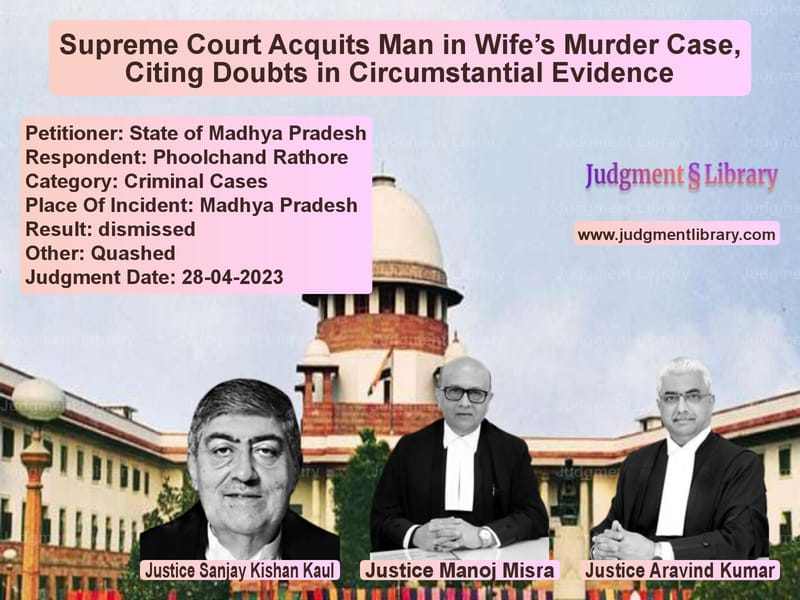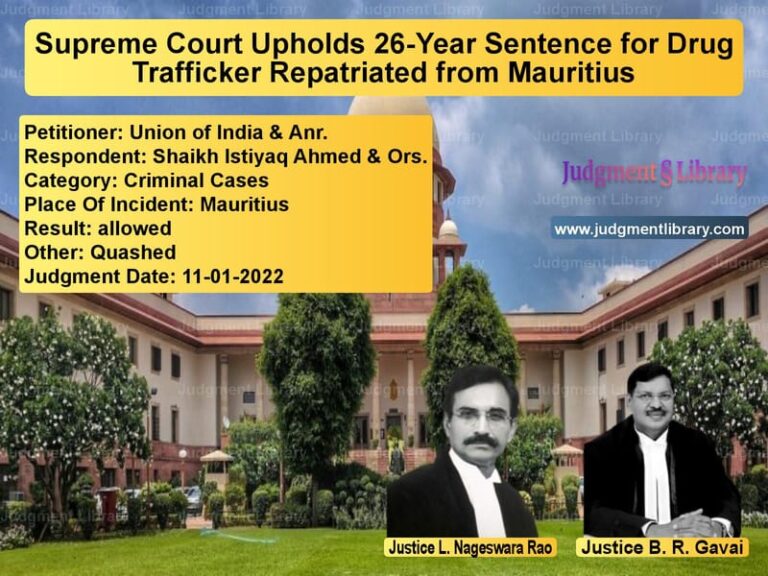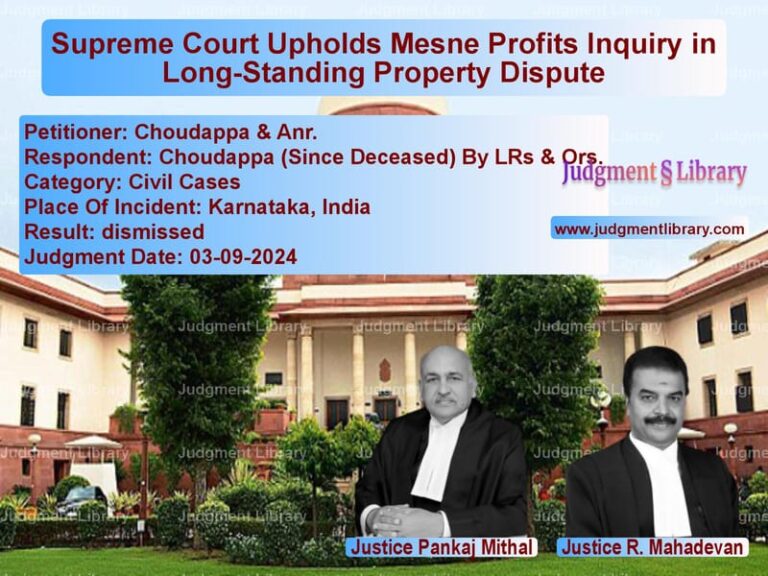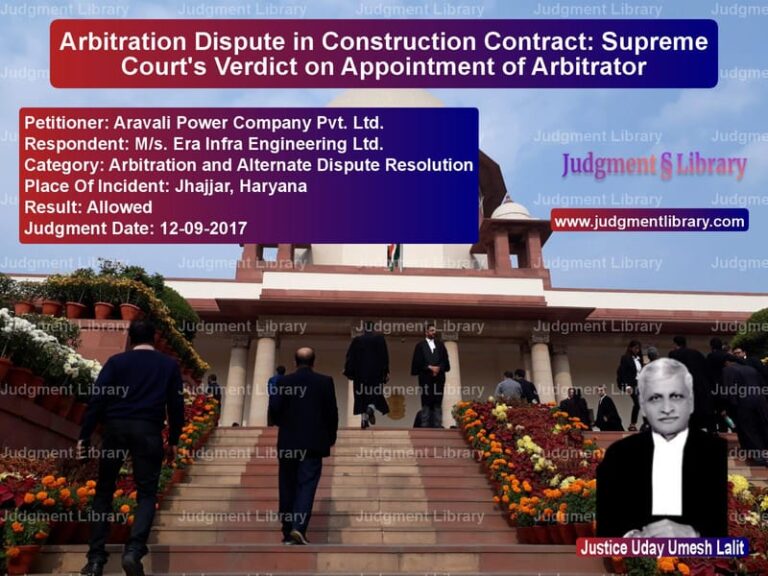Supreme Court Acquits Man in Wife’s Murder Case, Citing Doubts in Circumstantial Evidence
The Supreme Court of India recently ruled in the case of State of Madhya Pradesh v. Phoolchand Rathore, where the Madhya Pradesh government challenged the acquittal of the accused in a murder case. The case revolved around the death of the accused’s wife, with the prosecution relying solely on circumstantial evidence. The Supreme Court upheld the High Court’s decision to acquit the accused, citing inconsistencies in the prosecution’s case and a lack of conclusive evidence.
The judgment underscores the importance of proving each link in a chain of circumstantial evidence beyond a reasonable doubt. The Court observed that contradictions in witness statements and an unreliable motive weakened the prosecution’s case.
Case Background
The case pertained to the murder of Sundariya, the wife of the accused, Phoolchand Rathore. The prosecution alleged that Phoolchand bore a grudge against his wife over a dispute regarding her jewelry. On February 1, 2010, the accused allegedly took his wife towards the fields on a bicycle while threatening to kill her. Later that evening, she was found gravely injured near a railway track and succumbed to her injuries while being taken to the hospital.
The prosecution relied on the following circumstantial evidence:
- A dispute between the accused and his wife over jewelry.
- The accused was last seen with the deceased.
- Blood-stained clothes and stones recovered from his hut.
- An alleged extra-judicial confession to his daughter.
Trial Court Judgment
The Sessions Court convicted Phoolchand Rathore under Sections 302 and 201 of the Indian Penal Code (IPC). The trial court imposed the death penalty, concluding that the chain of circumstantial evidence was complete.
High Court Acquittal
On appeal, the High Court of Madhya Pradesh overturned the conviction, citing inconsistencies in the prosecution’s case:
- Unreliable Witness Testimony: The prosecution’s key witness, Madhuri (PW-4), the deceased’s daughter, made inconsistent statements.
- No Corroboration of the Motive: The alleged dispute over jewelry was found to be baseless as the jewelry had been returned before the incident.
- Doubtful Recovery of Evidence: The forensic evidence could not establish a direct link between the accused and the crime.
- Contradictions in the Arrest Record: Witnesses claimed the accused was arrested on the night of the incident, whereas police records suggested otherwise.
Supreme Court’s Observations
The Supreme Court upheld the High Court’s ruling, reiterating key principles in cases relying on circumstantial evidence:
1. Circumstantial Evidence Must Be Conclusive
The Court cited its previous rulings, stating that for a conviction based on circumstantial evidence, the prosecution must establish:
- The accused had a motive to commit the crime.
- The circumstances unerringly point to the accused’s guilt.
- The chain of evidence must exclude every possible hypothesis except guilt.
In this case, the Court found gaps in the prosecution’s narrative.
2. Unreliable Witness Testimony
The Supreme Court noted that Madhuri’s testimony contained several contradictions. She claimed:
- Her father forcibly took her mother on a bicycle.
- He later returned home with blood-stained clothes.
- He confessed to her about the murder.
However, the Court found that she did not disclose the confession in her initial statement. Further, two other witnesses, Ganga Bai (PW-1) and Sushila (PW-12), who were expected to corroborate her claims, denied any knowledge of the event.
3. Doubtful Recovery of Evidence
The prosecution relied heavily on the recovery of blood-stained clothes and stones. However:
- The forensic report did not establish that the blood was the deceased’s.
- The recovery was made from the accused’s hut, but the daughter’s testimony suggested the accused had washed the clothes and dried them elsewhere.
- The police officer who conducted the recovery admitted that witness signatures were taken at the station without explaining the documents.
4. No Clear Motive
The prosecution claimed that the accused was angry with his wife over her keeping jewelry with her sister. However, the jewelry had been returned before the incident. The High Court noted:
“The original motive for the crime was a dispute over jewelry, but it was later found that the jewelry had already been returned much before the incident.”
5. Accused’s Presence at the Crime Scene
The prosecution alleged that the accused was last seen with the deceased, which pointed to his guilt. However:
- The alleged time gap between when he was last seen and when the body was found was not accounted for.
- The accused was a farmer, and it was common for husbands and wives to visit fields together.
- The Court ruled that merely being last seen together does not automatically infer guilt.
Supreme Court’s Final Ruling
The Supreme Court dismissed the state’s appeal and ruled in favor of Phoolchand Rathore. The Court concluded:
“The view taken by the High Court is a plausible view, and it is not perverse so as to warrant interference by this Court.”
It upheld the principle that in cases based on circumstantial evidence, every link in the chain must be proven beyond a reasonable doubt.
Key Takeaways from the Judgment
- Circumstantial evidence must be conclusive and unbroken.
- Unreliable witness testimony weakens the prosecution’s case.
- Forensic evidence must establish a direct link between the accused and the crime.
- Merely being last seen with the deceased does not establish guilt.
- Acquittals cannot be overturned unless the High Court’s ruling is perverse or completely unreasonable.
Impact of the Judgment
This judgment reinforces the importance of adhering to strict standards in cases relying on circumstantial evidence. The ruling ensures that convictions are not based on speculation but on evidence that is conclusive and beyond a reasonable doubt.
For future cases, it sets a precedent that courts must be cautious in awarding the death penalty in cases lacking direct evidence and must ensure that the principles of fairness and justice prevail.
Petitioner Name: State of Madhya Pradesh.Respondent Name: Phoolchand Rathore.Judgment By: Justice Sanjay Kishan Kaul, Justice Manoj Misra, Justice Aravind Kumar.Place Of Incident: Madhya Pradesh.Judgment Date: 28-04-2023.
Don’t miss out on the full details! Download the complete judgment in PDF format below and gain valuable insights instantly!
Download Judgment: state-of-madhya-prad-vs-phoolchand-rathore-supreme-court-of-india-judgment-dated-28-04-2023.pdf
Directly Download Judgment: Directly download this Judgment
See all petitions in Murder Cases
See all petitions in Bail and Anticipatory Bail
See all petitions in Judgment by Sanjay Kishan Kaul
See all petitions in Judgment by Manoj Misra
See all petitions in Judgment by Aravind Kumar
See all petitions in dismissed
See all petitions in Quashed
See all petitions in supreme court of India judgments April 2023
See all petitions in 2023 judgments
See all posts in Criminal Cases Category
See all allowed petitions in Criminal Cases Category
See all Dismissed petitions in Criminal Cases Category
See all partially allowed petitions in Criminal Cases Category







